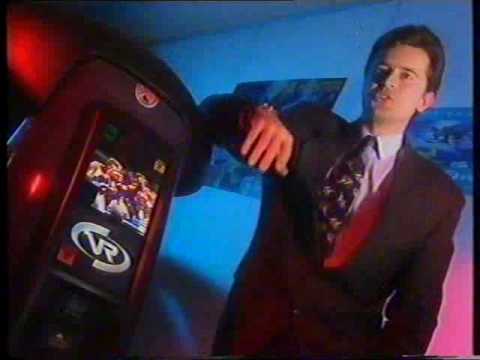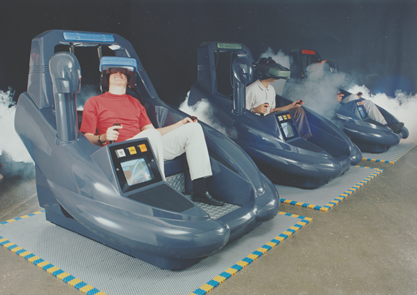It would be a mistake to name virtual reality as an achievement of the 21st century. In fact the earliest documented research we have on the phenomenon dates back to the 1950s. However, it was Virtuality, a company founded in England in the 1980s that brought the first wave of VR hype to the consumer, it was just a few decades ahead of its time.
See Also:
“The Pong Climbing Wall That’s Taking Over Finland”
“Take A Look Inside A Nintendo Power Line Counsellor Guide”
“5 Of The Best Retro Games Collectors On YouTube”
In 1987, Jaron Lanier popularised the term ‘virtual reality’. Just four years later, a group of guys were displaying their consumer VR flight simulator at Wembley Stadium with lines heading out the door. Virtuality began its life as W Industries, led by computer and VR fanatic Jonathan Waldern. Looking to the work of the developer of the first VR headset, Ivan Sutherland, Waldern developed an acoustic digitiser which he saw at the next step in this immersive technology.

He gathered a team to further his ambition, and they set out to bring VR to the public. Creating everything from scratch, they soon released their Virtuality pods at a 1990 computer graphics trade show where they sold their first two units to BT. British Telecoms wanted the technology for training and troubleshooting, and their first sale would ultimately lead the company down an industrial path. Soon they were invested with highly corporate companies developing pods as training and marketing tools. However this troubled Waldern, who saw his innovation as a means of play, a new way for people to interact with the computers that previously seemed so alien to them. This shift in business plan led them straight into the arcade.

In 1991, Virtuality released two types of 1000 series pods, one sitting and one standing. Both used headsets loaded with two LCD screens at 276 x 372, four speakers, and a microphone. The stand up pods utilised a tracking magnetic source that communicated with a receiver located in a free moving joystick that allowed the technology to pick up player movements as well as have the player roam the game world using the joystick.
Wembley Stadium, 1991, was the first time the public were able to buy all-inclusive VR pods. With arcade owners willing to pay upwards of $75,000 per machine in the days of $4,000 price tags, the show was a success. Dactyl Nightmare is possibly the most widely remembered title from this 1000 series. The pistol based dinosaur frenzy was a cacophony of blocky pillars and chequered platforms designed for 1-4 pterodactyl fearing players. It was the Virtuality 1000 series’ most successful title, and was repeated a year later on their next generation machine.

The 2000 series held an Intel 486-PC under the hood with a game repertoire boasting Dactyl Nightmare 2 – Race For The Eggs!, and even Pac-Man VR. However it was sadly the last major release for the company. Despite a spattering of spin off and specifically dedicated models, VR wasn’t living up to its hype back in the days of rudimentary graphics and slow processing. The people were expecting much more from the promises of revolution being offered them, and were disappointed at the stark results they were given. The early 90s also saw an explosion in the home console market that would soon put the arcade to bed, and pricey expenditures for fancy tech just wasn’t at the top of the arcade owner’s priorities in this dying time.

Virtuality is often brushed under the carpet, many are aware of Nintendo’s Virtual Boy, or even Sega’s brief foray into the virtual world. Though the arcade versions are often forgotten amongst the celebration of the home console and it’s these clunky grey machines that were the initial toe-dippers in VR waters.

